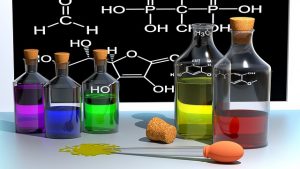Titration Calculations
Chemistry titration calculations are relatively easy. However, you must ensure that your chemical equation for the reacting species is stoichiometrically correct, since the titration calculations are based on the stoichiometry of the reacting species.
As a simple example, let us suppose that it takes 18.57 ml of 0.015 M hydrochloric (HCl) acid to neutralise 25 ml of sodium hydroxide (NaOH) solution of unknown concentration. What is the concentration of the sodium hydroxide solution?
Firstly, we write out the stoichiometric reaction between sodium hydroxide and hydrochloric acid as follows:
HCl + NaOH ——> NaCl + H2O
Secondly, we now work out the number of moles of HCl required to neutralise the 25 ml of NaOH. This is done by using the following formula:
number of moles of HCl = [volume of HCl in ml X concenetration of HCl in mol/L] / 1000
= [18.57 ml X 0.015 mol/L]/1000
= 2.7855 X 10^-4 moles
Thirdly, we see from the stoichiometric equation above that HCl reacts with NaOH in ratio 1:1. Therefore, the number of moles of NaOH that are needed to react with 2.7855 X 10^-4 moles will be the same, i.e., 2.7855 X 10^-4 moles.
Finally, in order to work out the unknown concentration of NaOH, we use the above formula
number of moles of NaOH = 2.7855 X 10^-4 = [volume of NaOH in ml X unknown concentration of NaOH] / 1000
Upon re-arranging, we have:
Unknown concentration of NaOH = [2.7855 X 10^-4 X 1000] / 25 ml
= 0.011 mol/L
Note: It is essential that you do not round of your answers at each stage as this will introduce errors in your final answer.
To learn more about chemistry calculations and the chemistry subject itself, book your tuition with us now, or call us on 079 5655 8523.
